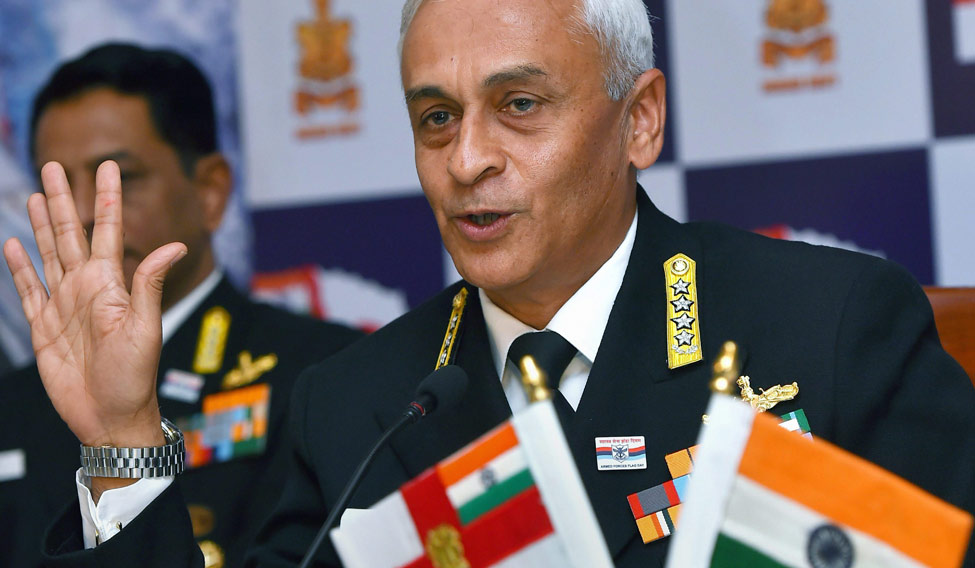Growing maritime prowess of China has led to its increased presence in the Indian Ocean region. The Indian Navy is closely monitoring the phenomenon, said Navy chief Admiral Sunil Lanba on Thursday, as Chinese submarines are also making regular forays into this region which is strategically important for India.
To counter the Chinese People Liberation Army (PLA) Navy's growing presence in the region, Indian Navy is expanding its reach by deploying its mission-ready ships and aircraft along critical sea lanes of communications and choke points in the Indian Ocean Region.
Observing that it is “rather odd” for Chinese submarines to undertake anti-piracy operations in the Gulf of Aden in the Indian Ocean, Lanba said the submarine is not the “ideal platform for such a role.” Like India and several other countries, China has also deployed a warship since 2008 to patrol the 450 nautical mile-long Gulf of Aden after piracy assumed alarming proportions. While no other country has deployed a submarine, China has said it uses submarines also to keep a watch on pirates. Even the United States has also criticised Chinese for deploying submarines for such operations.
As the Indian navy has decided to deploy about 14-15 ships year-round in the region with new mission-based deployment concept, it surely resulted in the Navy's high visibility in the Indian Ocean Region.
The areas where these ships, corvettes and surveillance aircraft are being deployed under the Navy's mission-based deployment include the Malacca Strait, Andaman Sea, North Andaman Sea, including Bangladesh and Myanmar, Lakshadweep islands and the Maldives, besides Madagascar and the Persian Gulf.
While giving out details of PLA Navy's presence, Admiral Lanba said that eight ships of Chinese PLA Navy are present in the Indian Ocean region at any given point of time, which started in 2008.
"Of the eight ships, three are part of anti-piracy, and twice a year a submarine comes with escort ships. In the month of August, there was a unique situation as there were 14 ships in the area," Lanba was addressing customary annual press meet ahead of Navy Day on December 4.
"PLA Navy submarine started its deployment in 2013, these are twice by two submarine for three months. One conventional submarine is followed by a nuclear submarine. No change in this pattern. This pattern is being followed since 2013. We monitor their deployment. Once in 24 hours or 48 hours, a surveillance aircraft goes for surveillance," the Navy chief said.
He also admitted that presence of Chinese submarines in the Indian Ocean region is a matter of concern and the Navy constantly carries out threat assessment. In fact, long range maritime reconnaissance aircraft conduct at least one sortie a day to track the surface warships accompanying the Chinese submarines, he said. The Navy has managed to detect the submarines “off and on,” Lanba said while adding aerial and electronic surveillance enables the Navy to have “transparency” of maritime domain and “we are aware where their(Chinese) ships are deployed.”
The Navy chief's reaction comes at a time when a few months back, Sri Lanka refused permission for patrolling Chinese submarines to enter their port. Moreover, last year the Indian Navy managed to detect Chinese submarines underwater at least two times while they were on their way to Karachi harbour.
Explaining further on the Navy's 'mission-based deployment', Lanba said that the Navy has now changed its operational deployment to mission-oriented patrolling. Facing challenge from China, the Navy has now permanently stationed a warship at the mouth of Strait of Malacca near Andaman and Nicobar Islands. Moreover, a warship is also permanently deployed in the Andaman Seas to patrol the sea lanes leading to the Strait of Malacca, Lanba said.
More than 70 per cent of Indian trade including import and export pass through the lanes in this region. China also keeps a watch as all its energy and oil requirements are ferried through the Strait of Malacca and Beijing feels it is a “choke point.”
Meanwhile, dismissing reports of US officials being given access to India's nuclear submarine INS Chakra, Navy chief said that the SONAR panels of INS Chakra were damaged and that inquiry has been initiated into the accident. A Russian newspaper Kommersant in its report on November 11, had claimed that the Indian Navy had allowed a US team to visit INS Chakra, a Russian nuclear submarine leased to India and termed the incident as as a "scandal" and a security breach that violated the contract between India and Russia.
"No US official was allowed to see INS Chakra even from a close distance,"Admiral Lanba clarified.
Chakra, an Akula class submarine was leased to Indian Navy by Russia for a period of 10 years at an estimated cost of $700 million, but ownership of the vessel still remains with Russia.
While on expansion plan for nuke submarines, India has launched its project to build six more nuclear-powered submarines. The nuclear power will allow them greater endurance under sea as the submarines need not surface to ‘breathe’.
“We have launched the project to make six SSNs (nuclear-powered submarines) and I will not say any further as it’s a classified project," said the Navy chief.





